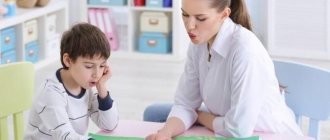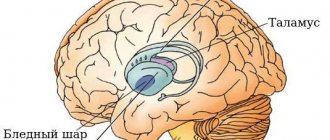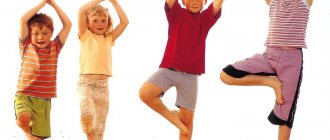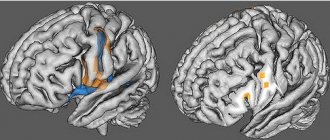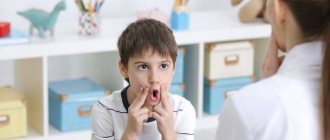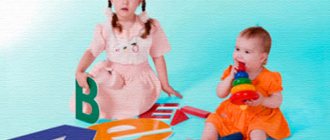Home → Information about diseases → Alalia signs, symptoms and treatment of sensory and motor alalia.
Alalia is the absence or underdevelopment of speech in children with normal hearing and primarily intact intelligence; The cause of Alalia is most often damage to the speech areas of the cerebral hemispheres during childbirth, as well as diseases of the nervous system or traumatic brain injuries suffered by the child in the pre-speech period of life. Severe degrees of Alalia are expressed in children by a complete absence of speech or the presence of babbling fragments of words; milder cases are characterized by limited vocabulary, agrammatisms, and difficulties in mastering reading and writing in the future.
Symptoms and signs of alalia.
Symptoms primarily depend on the type of alalia. Motor alalia has characteristic symptoms: poor development of hand movements; poor coordination; poor performance; speech can only appear by age 4; inability to express one's thoughts in words; replacing some words with others; incorrectly constructed sentences; reluctance to talk; touchiness, isolation, aggressiveness. Sensory alalia has characteristic symptoms: impaired speech perception; repeating words after someone; isolation; changing letters in words; merging several words into one; impulsiveness, increased activity, but at the same time the child may be withdrawn or depressed by something; lack of connection between an object and the word that denotes it.
FORMS OF ALALIA:
Pediatric neurologists and reflexotherapists distinguish 2 main forms of alalia: motor alalia, sensory alalia.
Tasks and exercises for sensory alalia
Speech therapy classes are conducted as part of complex therapy. At the same time, given that the violation is systemic in nature, work is being carried out “on all fronts.” The classes necessarily include exercises for the development of motor skills, attention, memory, and phonemic hearing.
It is important to consider that for children with sensory alalia, uncontrolled sound sources only slow down the correction process, overloading the psyche and not having any speech impact. Therefore, the first thing the specialist recommends is organizing regular “quiet time” in the family and generally limiting the sound environment. Against such a depleted sound background, the child’s sensitivity to speech increases. This state is used during classes.
Motor alalia.
Motor alalia (a. motoria; lat. motor motor) is an underdevelopment of expressive speech, expressed in the difficulty of mastering an active vocabulary and grammatical structure of the language with a fairly intact understanding of speech. Motor alalia is based on a disorder or underdevelopment of the analytical-synthetic activity of the speech motor analyzer, expressed, in particular, by the replacement of subtle and complex articulatory differentiations with coarser and simpler ones.
Causes of motor alalia.
The cause of motor alalia is damage to the cortical end of the speech motor analyzer (Broca's center) and its pathways, or a decrease in the functional activity of this center.
Motor alalia develops when the functions of the fronto-parietal areas of the cortex of the left hemisphere of the brain (Broca's center) are impaired and manifests itself in a violation of expressive speech with a fairly good understanding of addressed speech, late formation of phrasal speech (after 4 years) and poverty of pre-speech stages (frequent absence of babbling) . Accompanied by a gross violation of the grammatical structure (lack of agreement of words in gender, case and number, incorrect use of prepositions, absence of verbal forms in speech, rearrangement of syllables and sounds within a word, etc.). There is a pronounced poverty of vocabulary.
Motor alalia underlies disorders of school skills such as dyslexia and dysgraphia, as well as disorders of spatial gnosis and motor disorders such as apraxia; it is combined with local and diffuse neurological symptoms and damage to the structures of the dominant hemisphere, which determines the possibilities of expressive speech. In the mental state of children with a similar disorder, there are often manifestations of varying degrees of severity of psychoorganic syndrome in the form of motor disinhibition, attention and performance disorders in combination with intellectual development disorders.
Types of alalia
Doctors distinguish two types of disease, differing in nature and symptoms.
Motor alalia
This is a lack of expressive speech due to disruption of the part of the brain that is responsible for speech motor function. That is, the child understands everything, but cannot pronounce words and even syllables correctly, replacing some words or their elements with simpler or inarticulate sounds.
Sensory alalia
The second type is sensory alalia. Its definition is simpler - it is the inability of a child to understand speech in the absence of anomalies in the structure of the hearing aid.
The characteristics of this disease have long been developed by neurologists: with this type, areas of the brain designed to analyze auditory impulses are affected. In simple words, the child seems to hear the speech of those around him, but cannot make out what exactly they are saying; for him it is just a set of sounds.
Doctors distinguish three degrees of the disease:
- 1st – inability to understand and reproduce speech;
- 2nd – obvious speech problems;
- 3rd – individual errors in pronunciation.
Sensory alalia.
Sensory alalia (a. sensoria; lat. sensus feeling, sensation) is an underdevelopment of impressive speech, when there is a gap between the meaning and the sound envelope of words; the child’s understanding of the speech of others is impaired, despite good hearing and intact abilities to develop active speech. The cause of sensory alalia is damage to the cortical end of the auditory-speech analyzer (Wernicke's center) and its pathways.
Causes of sensory alalia.
The main cause of sensory alalia is damage to the temporal region of the left hemisphere (Wernicke's center) and is associated with disturbances in the acoustic-gnostic aspect of speech while hearing is intact. It manifests itself in insufficient understanding of addressed speech and a gross violation of its phonetic side with a lack of differentiation of sounds. In children, the correlation between an object and a word is difficult and delayed in development: they do not understand the speech of others, due to which expressive speech is extremely limited. Children distort words, mix sounds that are similar in pronunciation, do not listen to the speech of others, may not respond to calls, but at the same time react to abstract noises, echolalia is noted; auditory attention is sharply impaired, although the timbre of speech and intonation are not changed. In the mental state, there are signs of organic brain damage - often in combination with intellectual underdevelopment in a wide range (from mild partial developmental delays to mental retardation).
At the same time, this division is conditional, since in practice there are combinations of both motor Alalia and sensory and sensorimator Alalia.
Etiology and pathogenesis of alalia
There is no consensus in the literature on the etiology (causes) of alalia and its pathogenesis (brain mechanisms).
Some authors give preference to biological factors, others - socio-psychological, others - heredity, and others believe that the hereditary factor does not play a fundamental role in the occurrence of alalia.
Causes:
Biological
Proponents of the idea that alalia is a consequence of organic brain damage consider asphyxia to be the most dangerous etiological factor.
Asphyxia as the most likely cause of the development of alalia is also pointed out by such authors as V. Gardner, E.M. Mastyukova, B.V. Lebedev, G.V. Gurovets.
The French alalia researcher J. Ajuriaguerra, in addition, believed that alalia is caused only by bilateral brain lesions, in which spontaneous compensation of defects is impossible or extremely difficult.
It should be noted, however, that, according to numerous observations of clinicians, not all children with a history of the complications listed above develop alalia.
Some children who develop normally in terms of speech have asphyxia and various bilateral brain lesions that do not negatively affect the speech mechanism.
The views of different scientists on the role of heredity in the etiology of alalia are also not the same. V.A. Kovshikov conducted a special study of this problem.
He reports that heredity occurs only in a small number of cases - approximately 16% of the total number of alaliks.
The main argument is the data he obtained that the speech development problems that parents had are not always passed on to their children.
More significant, according to the conclusions of V.A. Kovshikov from a detailed review of the literature on alalia, factors such as late birth, induced and spontaneous abortions, a history of stillbirths, pathology of pregnancy, especially severe toxicosis in the first half.
Threatened miscarriages, psychological trauma, abnormal position of the fetus, bleeding, Rh incompatibility, premature birth, rapid, protracted, dry labor, stimulation, forceps, head injuries during childbirth, asphyxia and some other circumstances are also unfavorable.
Children who are born weakened and have suffered severe brain diseases before the age of one year, and especially neuroinfections, as well as children who have received head injuries before the age of one year, are also at risk.
Socio-psychological
American psychologist V. Gardner attaches great importance in the etiology of alalia to social factors: conflictual relationships in the family, improper upbringing of children (mockery over incorrect speech, etc.).
They pay special attention to the relationship between the child and the mother. He notes that among the mothers of alaliks, neurotic, timid, and, conversely, arrogant ones are much more common than among the mothers of normally speaking children.
There are conflicting opinions regarding the stay of children in a bilingual environment. Most of the authors, for example, A.V. Yarmolenko, do not recognize that bilingualism has a harmful effect on the development of alalia. Others consider it to provoke deviations in speech development.
Different views on the mechanism of alalia
Motor concept
The first noteworthy study of alalia belongs to A. Kussmaul, who back in 1877 called it “congenital aphasia.”
A little later, in 1888 , R. Cohen designated alalia as “ideopathic deafness” or “hearing-muteness.” Despite this designation, R. Cohen is considered a supporter of the motor concept of alalia.
He believed that the main thing in alalia was the absolute inability of children to pronounce sounds and syllables, although he recognized that the brain structures that are responsible for this may not be damaged in them. According to R. Cohen, this type of speech pathology is based on discoordination in the work of individual speech zones.
A follower of R. Cohen was the German neurologist G. Gutzmann, who also proposed intensively stimulating the articulatory side of speech in alaliks.
Psychological concept
However, the motor concept of alalia has not received universal acceptance. Researchers of the late 19th century, for example, A. Liebmann, M.V. Bogdanov-Berezovsky, expressed considerations according to which alalia cannot be caused only by motor reasons.
They believed that the main factor here was the psychological factor: disturbances in thinking, emotional-volitional sphere, memory, attention, etc.
A number of later researchers, following A. Kussmaul, considered alalia as an analogue of aphasia, only observed in children.
However, they had serious opponents who emphasized the fundamental difference in the mechanisms of development of aphasia and alalia. Despite these criticisms, the motor and sensory concept of alalia remained operational for a long time.
Sensory concept
At a later time, St. Petersburg neurophysiologist, psychologist, teacher N.N. Traugott, recognizing that with alalia the activity of language acquisition is always disrupted, noted that the root cause of this is the insufficiency of speech auditory gnosis.
The same point of view was expressed later, in the 60s of the 20th century , by R.E. Levina.
Mixed variants of brain mechanisms
The brain mechanisms of alalia may also be mixed. V.K. Orfinskaya allowed differences. She associated the inability of Alaliks to speak either with the presence of the phenomena of oral-articulatory apraxia, or with a deficiency of language ability and believed that there were:
a) the actual “linguistic” alalia, which consists of the inability to isolate from the speech of adults the rules of language necessary for the use of its means (phonemes, words, word forms, phrases);
b) gnostic and praxic, caused by speech auditory agnosia or articulatory apraxia.
Language concept
Currently, the priority is the “linguistic concept” of the pathogenesis of alalia. It is followed by many modern researchers of pathology of speech development: V.A. Kovshikov, N.S. Zhukova, E.M. Mastyukova, T.E. Filicheva, B.M. Grinshpun, V.K. Vorobyova, L.R. Davidovich, E.F. Sobotovich, T.G. Wiesel.
According to her, a child with alalia does not develop the “language ability” that is given to a person by nature. With both sensory and motor alalia, the child cannot master the language (its sounds, words, grammar).
At the same time, skills that do not require significant verbal accompaniment can be successfully developed (for example, the ability to draw, count, design, play various games not directly related to speech).
This is due to the fact that speech stimuli, especially with motor alalia, are perceived and inner speech is formed. It becomes the basis for mental development as a whole.
With sensory alalia, the formation of internal speech also occurs, but is reduced mainly to the visual perception of objects in the world and optical images of articulatory movements of adults.
Sensory children who do not receive timely help master non-speech skills to a lesser extent and often their mental development takes on the features of secondary mental retardation.
Neuropsychological approach
(The most likely brain mechanisms causing sensory and motor alalia)
In addition to the innate readiness for language development, primary intact intelligence, environmental stimuli that would encourage brain systems to mature, motivation for speech, it is necessary that between individual analyzers and the modalities built on them there are fully functioning pathways along which information is transmitted from one area of the brain to another.
This also applies to the actual speech areas of the brain. Without communication between individual areas of the brain involved in speech acquisition, speech cannot develop.
Let us consider which intersystem connections are not formed in the first place during sensory and motor alalia from a neuropsychological point of view.
Modern neurophysiological studies (M. Kinzborn, D.A. Farber, M.M. Bezrukikh, etc.) have shown that in early speech ontogenesis the processes of left hemisphere lateralization of speech function play an important role.
Initially, the child learns non-speech noises (natural - the sound of the wind, the rustling of leaves, the sound of pouring water, thunder, as well as the “voices” of animals; object noises made by various objects - tools, musical instruments, etc.).
These acquisitions of the right hemisphere serve as the basis for the primary operations of speech development. They consist in the selection from them by the left hemisphere mechanism of signs useful for speech.
All blows, bows, hisses, whistles, growls and moos in the left hemisphere must change and turn into speech sounds, which retain a connection with the original sounds in the names themselves. This is how speech auditory gnosis is formed.
The task of extracting features useful for speech from non-speech noise turns out to be inaccessible to the most difficult alaliks.
As is known from the literature, the pre-speech period proceeds without significant deviations, i.e. the same as in speech-healthy children.
They master, according to age parameters, various pre-speech skills: movements, including rhythmic, drawing, can imitate non-speech sounds, for example, the howling of the wind, the voices of animals; perform various household operations accompanied by gestures.
However, the preparatory phase of development for speech ends with these “ancient” skills. The sounds made by the human voice remain inaccessible to them unless appropriate corrective measures are taken.
In other words, speech auditory gnosis in these children is not formed or is formed slowly, defectively
The place of primary localization of speech auditory gnosis in the brain is the left temporal lobe.
It is clear that she can start working in a timely manner only if the child has accumulated the necessary non-speech auditory base and if the pathways between the hemispheres (and, first of all, the corpus callosum) are intact.
If these conditions are not met, the child does not acquire the ability to navigate acoustic noises as speech sounds and, therefore, does not understand what adults say.
Unlike sensory alalia, in which there are no necessary connections between the right and left hemispheres of the brain, with motor alalia the pathological process is concentrated primarily in the left (speech dominant) hemisphere.
Let’s say that a child has acquired, to some extent, the ability to distinguish speech sounds and grasp their semantic roles in language, i.e. non-speech noises were transformed into speech sounds. However, in order for him to speak on his own, this is not enough; he also needs the ability to re-encode these sounds into articulatory movements
They can be approximate, undifferentiated, but precisely articulatory (speech). To do this, it is necessary that speech products perceived by ear be recoded into articulatory movements.
This , in turn, is possible only if the pathways between the sensory (temporal) and motor (premotor and postcentral) areas of the brain are complete.
The frontal lobes also play a significant role in these processes, providing not a mechanical imitation of what is heard, but meaningful speech activity. These are the most likely brain mechanisms.
Correction and treatment of alalia
Timely and regular speech correction helps in most cases to correct the defect and, if not to turn the child into a speaker, then at least to almost equalize him with his peers. Unfortunately, severe forms are sometimes incurable, and the baby, even in adulthood, will be significantly behind in mental development.
As a rule, treatment is complex:
- physiotherapy (use of laser, electromagnetic radiation, hydrotherapy, acupuncture, UHF to stimulate brain function);
- speech therapy training with a specialist to develop articulation and clear pronunciation of sounds, letters and words;
- taking vitamin complexes to activate brain processes;
- consultations with a psychologist to eliminate possible deviations;
- Early attendance at kindergarten or child development groups is recommended for the child’s socialization.
If children have severe developmental disabilities, it may be easier to send them to a specialized boarding school for training, where specialists work with them around the clock. But not every parent agrees to this, right?
How to practice at home on your own
There are home methods for treating alalia, that is, not only specialists, but also parents themselves should deal with the problem.
Recommended:
- use finger games at home to stimulate biologically active points on the child’s fingertips;
- with sensory alalia, it is worth helping the baby associate words with their images, pictures; for this it is important to read books with pictures, name objects by pointing to them;
- talk to your child often, using simple, understandable words, pausing between phrases;
- learn to read and write as quickly as possible, this helps to “pull yourself up” and develop faster mentally, to keep up with your studies at school;
- constantly work on the correct pronunciation of words, correct the little one and ask him to repeat it as expected.
- You can use simple speech therapy games, warm-ups, and exercises. The main thing is to turn learning into a game, and not an obligation, and not to overexert the child.
